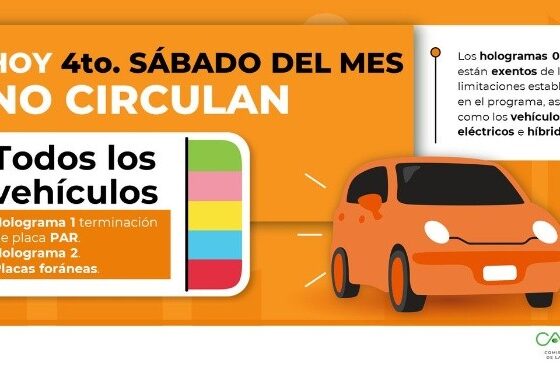The Hoy No Circula program, in force in Mexico City and in surrounding municipalities of the State of Mexico as a measure to reduce the emission of pollutants, is applied this November 22 in its modality on the fourth Saturday of the month:
- Hologram 1, termination of even plates (0, 2, 4, 6, 8 and 0)
- Hologram 2
- Foreign plates
Emergency vehicles, public transportation, electric or hybrid cars with a 0 or 00 hologram, motorcycles and those with license plates for people with disabilities are exempt.
In which municipalities is the Hoy No Circula program applied?
The Hoy No Circula program is applied from 5:00 a.m. to 10:00 p.m. in all the municipalities of Mexico City and in 18 suburban municipalities. from Atizapán de Zaragoza, Coacalco de Berriozábal, Cuautitlán, Cuautitlán Izcalli, Chalco, Chicoloapan, Chimalhuacán, Ecatepec de Morelos, Huixquilucan, Ixtapaluca, La Paz, Naucalpan de Juárez, Nezahualcóyotl, Nicolás Romero, Tecámac, Tlalnepantla de Baz, Tultitlán and Valle from Chalco, in the State of Mexico.
Likewise, it is applied in the metropolitan areas of Toluca and Santiago Tianguistenco.
Ignoring the rule can be punished with fines of 20 to 30 Update Measurement Units (UMA), equivalent to between 2,262 and 3,394 pesos.
Air quality in Mexico City
The Atmospheric Monitoring Directorate of Mexico City reported in its 6:00 a.m. report that the air quality in the country’s capital was “bad”, with a high risk level, due to the presence of pollutants PM₁₀ and PM₂.₅.
The Iztapalapa station reported the worst indicators and was marked in orange. For their part, the La Merced and Santiago Acahualtepec stations, in the country’s capital, were marked in yellow, “regular”, the same as Villa de las Flores and Tlalnepantla, in the State of Mexico.
The rest of the stations remained green (“good”).
The authorities recommend carpooling and avoiding outdoor activities between 1:00 p.m. and 7:00 p.m., especially if you are a child or older adult.
The Atmospheric Monitoring Directorate updates the air quality in the Valley of Mexico every hour, in order to alert the population and allow timely decision-making if pollution represents a risk.

